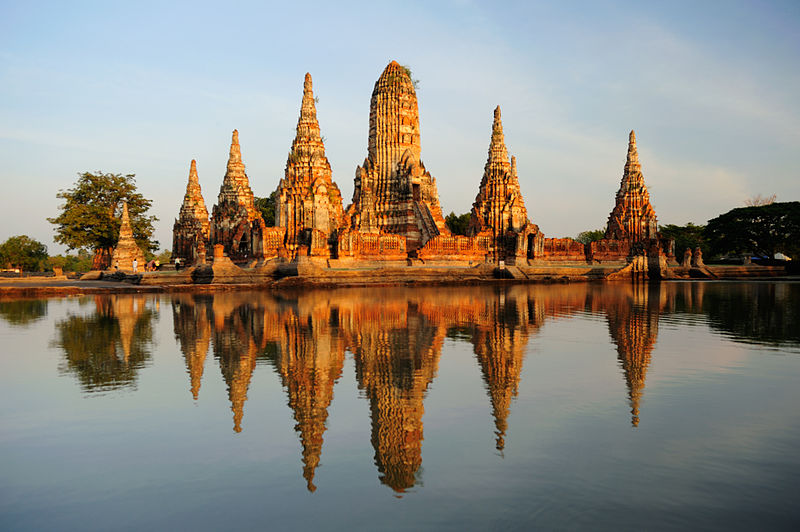What is Buddhism? Theravada and Mahayana
Budda isn’t just a happy idol you see when you go eat at your favorite Chinese or Thai restaurant, but it’s a philosophy that manifests into a culture, and a particular way of thinking in many Asian countries, including Thailand. Buddhism is based on the teachings of the Buddha, “the enlightened one.” It is a compassionate and tolerant religion that aims to alleviate suffering. 95% of the Thai people practice Theravada Buddhism, and it is the official religion of Thailand. In fact, Thailand is perhaps the only country in the world where the king is required to be Buddhist.
Theravada Buddhism is the second largest sect of Buddhism after Mahayana Buddhism. Theravada Buddhism is prevalent in Southeast Asia, especially in Thailand, Sir Lanka, Myanmar, Cambodia, and Laos; therefore it is sometimes called “Southern Buddhism.” Therevada means “Way of the Elders” and is the oldest branch of Buddhism. The Therevadians believe that they are most closely followed the original beliefs and practices of the Buddha and the early monastic Elders. The authoritative text for Thereavadas is the Pali Canon, an early Indian collection of the Buddha’s teachings. The purpose of life for Theravadians is to become an arhat, a perfected saint who has achieved nirvana and will not be reborn again.
Mahayana Buddhism “ The Greater Vehicle” is known as the more liberal and accessible version of Buddhism. It is a path available to people from all walks of life and not just monks. Mahayana followers are mainly found in North Asia and the Far East, including China, Japan, Korea, Tibet, and Mongolia, and are known as Northern Buddhism. However Mahayana Buddhist hope to not become arhats but boddhisatvas, saints who have become enlightened, but who unselfishly delay nirvana to help others attain it as well, like Buddha did. Mahayana Buddhists teach that enlightenment can be attained in a single lifetime, and this can be accomplished even by an average joe, unlike in Therevada, which believes enlightenment only possible for monks and nuns who devote their entire lives to the task. Thus, in the Theravada sect, the best outcome for an average man is to be reborn in the monastic life. As a result, Southern Buddhism tends to be more monastic, strict and world renouncing than its Northern counterpart, but also has a more philosophical than religious approach than Mahayana Buddhism.
Brief History of Buddhism in Thailand
It is widely believed by Thais, that Emperor Ashoka from India sent Buddhist missionaries to Thailand in the 3rd century B.C. Today this influence can be seen in Thailand, several thousands of years later, as evidenced by numerous images of Vishnu, Shiva and Buddha, found in early sites in Thailand. Animism found in Thailand before both Hinduism and Buddhism in Thailand and has persisted to the present day as well, mainly in the form of spirit shrines in doors, yards and businesses.
By the 6th century A.D. Buddhism was well established in south and central areas of what is now Thailand, after the Mons of southern Burma adopted Theravada Buddhism and later invaded the central valley of Thailand. They left numerous stupas and a distinctive style of Buddhist image.
Theravada Buddhism in Thailand was further strengthened after King Anawrahta of Burma captured Thailand in 1057 A.D, he spread Theravada into northern Thailand. Later, when the Thai Kingdom of Sukhothai was formed in 1238 A.D. Theravada Buddhism became the state religion. As Thailand was never conquered by any colonial European powers, thus wasn’t subjected to assaults by Christian missionaries or imposed Western influence.
How does Theravada Buddhism manifest itself in Thailand?
Buddhism in Thailand is infused with many spiritual beliefs, which are likely the result of lingering animist, and Hindu beliefs from centuries earlier. Most Thai homes and places of business feature a ‘spirit house’ just outside the building, where offerings are made to appease spirits that might otherwise inhabit their homes or workplaces. Furthermore, Buddhist monks are often brought to new homes and businesses to ‘bless them’, and Thai people frequently light incense and make prayers to both Buddha images and a host of Hindu gods, whose shrines are located throughout Bangkok and the countryside.
Visitors to Thailand will encounter Buddhism in many aspects of Thai life. Many foreigners view “The Land of Yellow Robes” as the vision of yellow robes of the Buddhist monks are seen from the moment one steps inside the country. Senior monks are highly revered in Thailand and it isn’t uncommon to see their images adorning walls of businesses or homes or upon ornaments inside of taxi cabs. In many towns and villages the neighborhood wat (temple) is the heart of social and religious life. Buddhist holidays occur regularly throughout the year (particularly on days with full moons) and many Thai people go to the wat on these and other important days to pay homage to the Buddha and give alms to monks in order to make merit for themselves. Meditation, a primary practice of Buddhism is also popular as a means of self-reflection in order to identify the causes of individual desire and ultimately alleviate ones suffering.
To learn more about Thailand, attend Destination Thailand in Atlanta on October 16, 2014!



